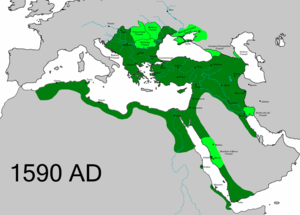Treaty of Constantinople (1590)

The Treaty of Constantinople, also known as the Peace of Istanbul[1][2] or the Treaty of Ferhad Pasha[3] (Turkish: Ferhat Paşa Antlaşması), was a treaty between the Ottoman Empire and the Safavid Empire ending the Ottoman-Safavid War of 1578-1590. It was signed on 21 March 1590 in Constantinople (present-day Istanbul). The war started when the Ottomans, then ruled by Murad III, invaded the Safavid possessions in Georgia, at a period when the Safavids were weak.[4] With the empire beleaguered on numerous fronts and its domestic matters plagued by civil wars and court intrigues, the new Safavid king Abbas I, who had ascended the throne in 1588, opted for unconditional peace, which lead to the treaty. The treaty put an end to 12 years of hostilities between the two arch rivals.[1] While both the war and the treaty were a success for the Ottomans, and severely disadvantageous for the Safavids, the new status quo proved to be short lived, as by the next bout of hostilities, several years later, all Safavid losses were recovered.
War
At the time the war commenced, the Safavid Empire was in a chaotic state, and under its weak ruler Mohammad Khodabanda, the Ottomans had managed to take most of the Safavid provinces of Azerbaijan (incl. the former capital Tabriz), Kartli and Kakheti, Karabagh, Erivan, Shirvan and Khuzestan,[1] despite Mohammad Khodabanda's initially successful counterattack mainly led by Shahnavaz Khan (Simon I).[3] Following the ascension of Abbas I to the throne in 1588, in a time when the Safavid state was still plagued by domestic issues, the Ottomans still managed to push further, taking Baghdad in the very same year and Ganja in Shirvan shortly after.[1] Confronted by even more problems (i.e. civil wars, uprisings,[5] and the war against the Uzbeks in the northeastern part of the realm), Abbas I agreed to sign a humiliating treaty with disadvantageous terms.[6][7]
Treaty
According to the treaty, the Ottoman Empire kept most of its gains in the war. These included most of the southern Caucasus (which included the Safavid domains in Georgia, composed of the Kingdoms of Kartli and Kakheti, as well as the Erivan Province, Karabakh, and Shirvan), the Azerbaijan Province (incl. Tabriz, but not Ardabil, which remained in Safavid hands), Luristan, Dagestan, most of the remaining parts of Kurdistan, Shahrizor, Khuzestan, Baghdad and Mesopotamia.[8] A clause was included in the treaty that stipulated that the Safavids would have to stop cursing the first three caliphs,[9][10] as was common ever since the first major Ottoman-Safavid treaty, namely the Peace of Amasya (1555). The Persians also agreed to pay obeisance to religious leaders of the Sunni faith.
Aftermath
This treaty was a success for the Ottoman Empire, as vast areas had been annexed. However, it was not long lasting. Abbas I, who now used the time and resources as a result of the peace on the main front with the Ottomans, would successfully deal with the other issues (amongst which, the Uzbeks and the revolts), and bided for a suitable moment to regain his possessions.[11][2] When the Ottoman Empire was engaged with the Jelali revolts, he was able to regain most of his losses, which the Ottoman Empire had to accept in the Treaty of Nasuh Pasha, 22 years after this treaty.
See also
References
- ^ a b c d Roemer 1986, p. 266.
- ^ a b Mitchell 2009, p. 178.
- ^ a b Mikaberidze 2011, p. 698.
- ^ Mikaberidze 2011, pp. 95, 698.
- ^ Such as in Shirvan, which was sparked due to heavy taxation (Matthee (1999), p. 21)
- ^ Bengio & Litvak 2014, p. 61.
- ^ Prof. Yaşar Yücel-Prof. Ali Sevim:Türkiye Tarihi III, AKDTYKTTK Yayınları, 1991, pp. 21-23, 43-44
- ^ Mikaberidze (2011), p. 698; Meri & Bacharach (2006), p. 581; Iorga (2009), p. 213; Floor & Herzig (2015), p. 474; Newman (2012), p. 52; Bengio & Litvak (2014), p. 61; Mitchell (2009), p. 178
- ^ Floor & Herzig 2015, p. 474.
- ^ Newman 2012, p. 52.
- ^ Blow 2009, p. 36.
Sources
- Blow, David (2009). Shah Abbas: The Ruthless King Who Became an Iranian Legend. I.B.Tauris. ISBN 978-0857716767.
{{cite book}}: Invalid|ref=harv(help) - Iorga, Nicolae: Geschichte des Osmanischen Reichs Vol. III, (trans: Nilüfer Epçeli) Yeditepe Yayınları, 2009, ISBN 975-6480-20-3
- Floor, Willem; Herzig, Edmund (2015). Iran and the World in the Safavid Age. I.B.Tauris. ISBN 978-1780769905.
{{cite book}}: Invalid|ref=harv(help) - Matthee, Rudolph P. (1999). The Politics of Trade in Safavid Iran: Silk for Silver, 1600-1730. Cambridge University Press. ISBN 978-0521641319.
{{cite book}}: Invalid|ref=harv(help) - Meri, Josef W.; Bacharach, Jere L. (2006). Medieval Islamic Civilization: L-Z, index. Taylor & Francis. p. 581. ISBN 978-0415966924.
{{cite book}}: Invalid|ref=harv(help) - Mikaberidze, Alexander (2011). "Ottoman-Safavid Wars". Conflict and Conquest in the Islamic World: A Historical Encyclopedia. ABC-CLIO. ISBN 978-1598843361.
{{cite book}}: Invalid|ref=harv(help) - Mitchell, Colin p. (2009). The Practice of Politics in Safavid Iran: Power, Religion and Rhetoric. I.B.Tauris. ISBN 978-0857715883.
{{cite book}}: Invalid|ref=harv(help) - Roemer, H. R. (1986). "The Safavid Period". In Jackson, Peter; Lockhart, Laurence (eds.). The Cambridge History of Iran. Vol. 6. Cambridge University Press. ISBN 978-1139054980.
{{cite book}}: Invalid|ref=harv(help)CS1 maint: postscript (link) - Newman, Andrew J. (2012). Safavid Iran: Rebirth of a Persian Empire. I.B.Tauris. ISBN 978-0857716613.
{{cite book}}: Invalid|ref=harv(help)
